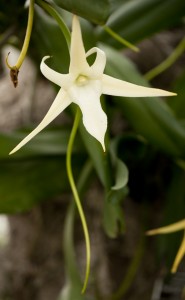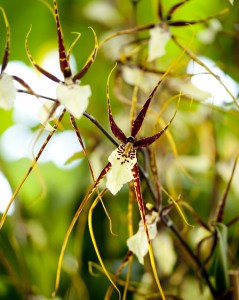A Tale of Two Orchids
Posted in The Orchid Show on April 8 2013, by Christian Primeau
Christian Primeau is the NYBG‘s Manager of the Enid A. Haupt Conservatory.

Orchids are wildly fascinating. Whether you enjoy them on a purely aesthetic level or delve more deeply into the evolution and specialization of certain species, you cannot help but draw a deep sense of satisfaction from these plants. For natural pollinators of orchids however, the “orchid experience” can prove the best of times or the worst of times, depending on which flower attracts their attention. To that end, this is a tale of two orchids.
Perhaps you’ve heard of the legendary Darwin’s Orchid, Angraecum sesquipedale. This lovely Madagascar native’s large, star-shaped flowers are annual jaw-droppers in the NYBG’s Orchid Show, often drawing throngs of eager fans and photographers. As the story goes, Charles Darwin studied the narrow, 10-15” long, nectar-filled spur that hangs from the rear of each flower, surmising that whichever creature fed on the nectar (and subsequently pollinated the orchid) must posses a proboscis of truly epic proportion. His hypothesis was largely ignored or ridiculed, leaving the mystery of the Angraecum pollinator to remain unsolved for decades. Unfortunately, Darwin would not survive to see his theory substantiated.
When the elusive culprit was finally discovered in 1903, 21 years after Darwin’s death, credit was given where it was due and both insect and orchid were named after the perceptive naturalist. Silently, and under cover of darkness, a species of African hawk moth hovers before the Angraecum flower, unfurls its delicately coiled, foot-long proboscis, and sips the lily-scented nectar from the spur, pollinating the flower in the process; you can see the moth in action for yourself in this clip. It is a textbook example of a plant and pollinator co-evolving to establish a mutually rewarding arrangement. Darwin would have been proud.

Other plants are not so generous and have nothing as heavenly as the Angraecum’s nectar to offer prospective pollinators. I regret to inform you that, as a result, many orchids have resorted to fraud and petty trickery. Shocking, but true! Take for example the curious Brassia species native to the Tropical Americas and West Indies, commonly referred to as Spider Orchids. What is a Spider Orchid in need of pollinating to do? Well, nothing really, apart from hang there and look exactly like a big old spider. It just so happens that certain wasp species find big old spiders thoroughly irresistible and will target them as a food source for their young.
While the unsuspecting wasp stings what should be the back of the “spider,” it unwittingly dislodges the Brassia flower’s pollinium (a mass of pollen grains), which is then transferred to the next incognito Spider Orchid flower it strikes, effectively fertilizing the plant. While the Brassia is perfectly happy with this exchange, the poor Spider-hunter Wasp is left with absolutely nothing to show for its effort and exertion. But hey, sometimes dinner plans go awry… we’ve all been there.
These are but two tasty tidbits of adaptation–a tiny glimpse into the amazing and intricate world of orchids. Remember, for every dazzling orchid flower you see in the show, there is likely an equally fascinating story behind it. Perhaps it’s a feel-good story, a mystery, or a tale of deception. But one thing is certain: orchids will never fail to captivate. Come for a visit–I think you’ll agree.


you painted a beautiful story with words and managed to capture what folks must feel when they come to the NYBG Orchid Show….fascination, captivation and wonder….
a few years back the Museum of Natural History in NYC had a show about Darwin and we picked up the book “Darwin: Discovering the Tree of Live”…when the dust of this spring settles, I need to reread the book…
there must be hundreds if not thousands of examples of co-evolution at the NYBG…can’t wait for your next installment…